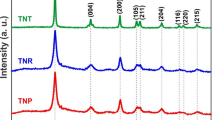Abstract
The microstructure design of TiO2 nanoparticles for photoanodes is an important issue in optimization of dye-sensitized solar cell (DSSC) performance. Up to date, the nanostructured TiO2 particles have been extensively employed as active layers. However, less attention has been focused on the development of various TiO2 nanostructures as the light-scattering layers (LSLs). In the present work, a facile hydrothermal method was utilized to prepare quasi-cube TiO2 (qcTiO2) nanoparticles as the LSL for the DSSC photoanode. The anatase qcTiO2 nanoparticles had a size distribution of 30–60 nm. The photoconversion efficiency of the cell with the qcTiO2 LSL was enhanced 12 %, compared to the TiO2 film without a scattering layer. The above enhancement was further vindicated by the incident photon-to-current efficiency measurement. The effect of the qcTiO2 LSL on electron transport and charge recombination of the DSSC was studied by electrochemical impedance spectroscopy. The experiment results revealed that the enhanced photovoltaic performance is attributed to the better light-harvesting capacity, longer electron life time, and less charge recombination of the qcTiO2 nanoparticles.






Similar content being viewed by others
References
Adachi M, Sakamoto M, Jiu J, Ogata Y, Isoda S (2006) Determination of parameters of electron transport in dye-sensitized solar cells using electrochemical impedance spectroscopy. J Phys Chem B 110:13872–13880. doi:10.1021/jp061693u
Aswani Y, Lee HW, Tsao HN, Yi C, Chandiran AK, Nazeeruddin MK, Diau EW-G, Yeh CY, Zakeeruddin SM, Grätzel M (2011) Porphyrin-sensitized solar cells with cobalt (II/III)–based redox electrolyte exceed 12 percent efficiency. Science 334:629–634. doi:10.1126/science.1209688
Bwana NN (2009) Comparison of the performances of dye-sensitized solar cells based on different TiO2 electrode nanostructures. J Nanopart Res 11:1917–1923. doi:10.1007/s11051-008-9545-2
Chae J, Kanb M (2011) Cubic titanium dioxide photoanode for dye-sensitized solar cells. J Power Source 196:4143–4151. doi:10.1016/j.jpowsour.2010.12.109
Dubey M, Shrestha M, Zhong Y, Galipeau D, He H (2011) TiO2 nanotube membranes on transparent conducting glass for high efficiency dye-sensitized solar cells. Nanotechnology 22:285201. doi:10.1088/0957-4484/22/28/285201
Fabregat-Santiago F, Garcia-Belmonte G, Mora-Sero I, Bisquert J (2011) Characterization of nanostructured hybrid and organic solar cells by impedance spectroscopy. Phys Chem Chem Phys 13:9083–9118. doi:10.1039/C0CP02249G
Fan X, Chu Z, Wang F, Zhang C, Chen L, Tang Y, Zou D (2008) Wire-shaped flexible dye-sensitized solar cells. Adv Mater 20:592–595. doi:10.1002/adma.200701249
Huang F, Chen D, Zhang XL, Caruso RA, Cheng YB (2009) Mesoporous anatase TiO2 beads with high surface areas and controllable pore sizes: a superior candidate for high-performance dye-sensitized solar cells. Adv Mater 21:2206–2210. doi:10.1002/adma.200802603
Kroon JM, Bakker NJ, Smit HJP, Liska P, Thampi KR, Wang P, Zakeeruddin SM, Grätzel M (2001) Photoelectrochemical cells. Nature 414:338–344. doi:10.1038/35104607
Prasittichai C, Hupp JT (2010) Surface modification of SnO2 photoelectrodes in dye-sensitized solar cells: significant improvements in photovoltage via Al2O3 atomic layer deposition. J Phys Chem Lett 1:1611–1615. doi:10.1021/jz100361f
Shao W, Gu F, Gai L, Li C (2011) Planar scattering from hierarchical anatase TiO2 nanoplates with variable shells to improve light harvesting in dye-sensitized solar cells. Chem Commun 47:5046–5048. doi:10.1039/C1CC10548E
Wang M, Chen P, Humphry-Baker R, Zakeeruddin SM, Grätzel M (2009) The influence of charge transport and recombination on the performance of dye-sensitized solar cells. ChemPhysChem 10:290–299. doi:10.1002/cphc.200800708
Wang HH, Su C, Wu CY, Tsai HB, Li CY, Li RW (2013) Preparation of composite light-scattering layer for dye sensitized solar cells. Thin Solid Films 529:15–18. doi:10.1016/j.tsf.2012.07.079
Wijeratnea K, Akilavasana J, Thelakkatb M, Bandaraa J (2012) Enhancing the solar cell efficiency through pristine 1-dimentional SnO2 nanostructures: comparison of charge transport and carrier lifetime of SnO2 particles versus nanorods. Electrochim Acta 72:192–198. doi:10.1016/j.electacta.2012.04.016
Wu X, Lu GQ, Wang E (2011) Shell-in-shell TiO2 hollow spheres synthesized by one-pot hydrothermal method for dye-sensitized solar cell application. Energy Environ Sci 4:3565–3572. doi:10.1039/C0EE00727G
Wu D, Zhu F, Li J, Dong H, Li Q, Jiang K, Xu D (2012) Monodisperse TiO2 hierarchical hollow spheres assembled by nanospindles for dye-sensitized solar cells. J Mater Chem 22:11665–11671. doi:10.1039/C2JM30786C
Yang SC, Yang DJ, Kim J, Hong JM, Kim HG, Kim ID, Lee H (2008) Hollow TiO2 hemispheres obtained by colloidal templating for application in dye-sensitized solar cells. Adv Mater 20:1059–1064. doi:10.1002/adma.200701808
Yu H, Bai Y, Zhong X, Tang F, Lu GQ, Wang L (2012) Cubic CeO2 nanoparticles as mirror-like scattering layers for efficient light harvesting in dye-sensitized solar cells. Chem Commun 48:7386–7388. doi:10.1039/C2CC32239K
Zhang H, Chen G, Bahnemann DW (2009) Photoelectrocatalytic materials for environmental applications. J Mater Chem 19:5089–5121. doi:10.1039/B821991E
Author information
Authors and Affiliations
Corresponding authors
Additional information
Hsuan-Ching Lin has contributed equally to this work.
Rights and permissions
About this article
Cite this article
Chen, HS., Lin, HC., Su, C. et al. Novel quasi-cube TiO2 nanoparticles as light-scattering layers for dye-sensitized solar cells. J Nanopart Res 15, 1836 (2013). https://doi.org/10.1007/s11051-013-1836-6
Received:
Accepted:
Published:
DOI: https://doi.org/10.1007/s11051-013-1836-6




